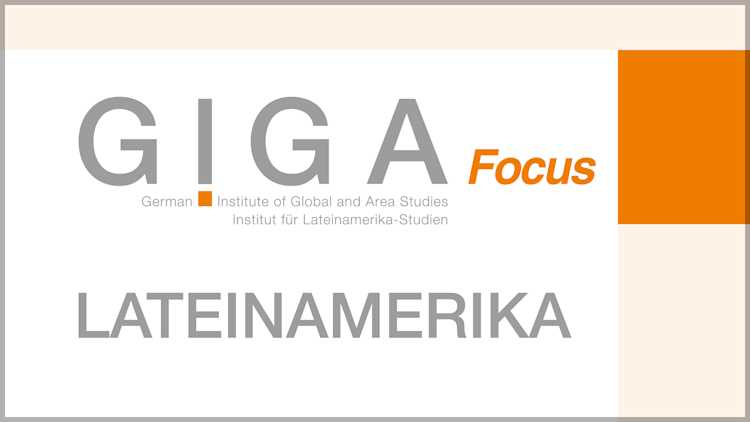- Home
- Publications
- GIGA Focus
- China Is Challenging but (Still) Not Displacing Europe in Latin America
GIGA Focus Latin America
China Is Challenging but (Still) Not Displacing Europe in Latin America
Number 1 | 2018 | ISSN: 1862-3573

While Latin America’s trade with China is flourishing again, and China’s government is courting Latin America, the European Union risks being outpaced. This is demonstrated by new cooperation initiatives within the framework of the second China–CELAC forum, which took place in Santiago de Chile on 21–22 January 2018. By contrast, the third summit between the European Union and CELAC (Community of Latin American and Caribbean States), originally scheduled for October 2017, was postponed indefinitely.
China has displaced Europe as the second-most important trade partner of Latin America behind the United States; in some of the region’s countries it has even become the most important trade partner. To further expand trade, the Chinese government invited Latin American governments to join the Road and Belt Initiative (RBI).
European foreign direct investment (FDI) is still much more important in Latin America than Chinese FDI. But China is expanding and diversifying its investments in the region, and it has become an important lender.
China’s relations with Latin America are pragmatic, covering a broad political spectrum and evincing a strong focus on economic topics. But China is also projecting soft power to advance its interests in Latin America, promoting Chinese culture, fostering academic exchange, and welcoming future political leaders.
While China has been able to take advantage of the United States’ disregard of Latin America, the European Union has not lived up to expectations: it neither concluded the negotiations of a free trade agreement with Mercosur, nor managed to upgrade its existing agreements with Chile and Mexico, developments that had been expected to take place in 2017.
Policy Implications
Europe should take the Chinese challenge in Latin America more seriously, and the European Union should engage more with Latin America and develop a clear strategy. Concluding and improving upon free trade and cooperation agreements with Latin America should be a high priority. Latin American and Caribbean governments are interested in creating a win-win situation and cooperating with both China and Europe. China is not displacing Europe in Latin America, but it is expanding into areas vacated by the European Union.
China Has an Eye on Latin America
At the end of Barack Obama’s tenure as US president, Miami Herald columnist Andrés Oppenheimer (2016) wrote, “So far, Xi has visited 10 Latin American countries since he took office three years ago, almost as many as the 11 [visited] by President Barack Obama during his eight years in office.” After the election of Donald Trump, Chinese president Xi Jinping lost no time capitalising on the opportunity of the Asia-Pacific Economic Cooperation (APEC) summit in Lima in November 2016 to present himself as a defender of free trade against the protectionist threats of the incoming US president. The Financial Times published an article titled, “Trump builds walls, Xi builds bridges in LatAm” (Gallagher 2016a). During his third visit to Latin America since becoming president in 2013, Xi Jinping not only made a stopover in Peru but also travelled to Ecuador and Chile. During those visits, he announced the establishment of comprehensive strategic cooperative partnerships with both countries. Hence, Ecuador and Chile have been promoted to the same level of partnership as Brazil, Mexico, Argentina, Venezuela, and Peru.
In November 2016 the Chinese government, replacing a document from 2009, published a policy paper on Latin America and the Caribbean that updates the strategy for the region. From the document it can be gleaned that China strives to make headway in Latin America. China’s demand for natural resources fuelled the commodities boom in Latin America (2004–2013). From a Latin American perspective, China’s growing economic presence in Latin America has stabilised the region more than its relations with other international partners (Gomis 2017). But China also supported Latin America (for example, as a lender) in the period of economic downturn, and it is keen to expand its influence now that Latin America is recuperating from recession. By chance, the second China–CELAC forum in Santiago de Chile was set for a date when Latin American economies were recovering, when the United States was alienating its Latin American partners, when EU–Latin American relations were stuck due to internal conflicts in Latin America, and when only incremental advances were being made in bi-regional trade negotiations.
More Than One Triangular Relation
US politicians and researchers like to describe the economic and political advances of China in Latin America from the perspective of a triangular relationship with a still-dominant role for of the United States. Renowned China specialist Kevin Gallagher (2016b) argued that Latin America has to navigate through the “China triangle,” where the United States possesses comparative advantages. His main arguments are that the manufacturing sectors in Latin America are much more integrated with US value chains than with Asian value chains, and that the United States imports a higher percentage of manufactured products from Latin America; moreover, US FDI in the region is much more diversified than China’s in regard to economic sectors. Gallagher’s book does not mention Europe even once, as it is, from this US perspective, not an actor of relevance in Latin America compared to China and the United States.
This US view of its former “backyard” is definitively distorted. The European Union might have lost some of its glamour, but Europe is still present in Latin America; indeed, some analysts (Gomis 2017) argue for the existence of a triangular relationship between China, Europe, and Latin America. Moreover, Asia is not only China – particularly Japan, but also South Korea and, to a certain extent, Taiwan, have strong economic links with Latin America as well. Additionally, India may become another important partner of Latin America in the future. Furthermore, the current multipolar world gives more leeway than a strictly bipolar one would to regional middle powers in Latin America for cross-regional relations, as is evident in the case of the member countries of the Pacific Alliance (Garzon and Nolte 2018) reaching out to Asia. On 22 January 2018, the day the China–CELAC forum ended, the Japanese prime minister announced that, in March of this year, 11 countries – including Chile, Mexico, and Peru – will sign the Comprehensive and Progressive Agreement for Trans-Pacific Partnership (TPP-11), which will include neither China nor the United States.
While the United States has been experiencing a significant reduction of its participation in Latin American trade since around the turn of the millennium (from 56 per cent of Latin American exports in 2001 to 46 per cent in 2016; and from 46 per cent of Latin American imports in 2001 to 32 per cent in 2016) (Novak and Namihas 2017), it is still Latin America’s most important trade partner, which is thanks to the United States’ strong trade links with Mexico and Central America. But US comparative advantages in Latin America might become mitigated by US president Donald Trump’s protectionist policies and by changing Chinese investment patterns. In contrast to the Chinese charm offensive, the US government is not showing any major interest in Latin America. In his first year, President Trump did not visit Latin America; if, as has been speculated, he ends up skipping the next Summit of the Americas in Lima in April 2018, he would be the first US president since the establishment of this format to do so. US secretary of state Rex Tillerson set the example when he declined to participate in important foreign minister meetings within the framework of the Organization of American States (for example, those in which policies to confront the Venezuelan crisis were discussed). Moreover, in the year since his inauguration, Trump has failed to appoint an assistant secretary of state for Western Hemisphere Affairs. What is worse, the current US administration has pursued a purely “negative agenda” (Oppenheimer 2017) against Latin America, opposing trade liberalisation and immigration, and denigrating “illegal immigrants” as criminals and rapists. Therefore, it is no surprise that Trump has become the most unpopular president in recent times in Latin America, far outpacing even George W. Bush in this regard (Latinobarometro 2017).
This shift in US Latin America policy might represent a chance for Europe to improve its position and regain terrain in Latin America. After the inauguration of President Trump, there were expectations and announcements that the European Union would strive to renew and update the existing agreements with Chile and Mexico and sign a new free trade agreement with Mercosur before the end of 2017. But this target was missed. Moreover, the EU–CELAC summit scheduled for October 2017 had to be postponed due to the conflicts between the Latin American governments on how to confront the Venezuelan crisis.
China Is Advancing in Latin America, but Europe Is Still There
While China and the European Union are competing in Latin America, they are also important trade partners. In 2016, 20.1 per cent of EU imports came from China, and 9.7 per cent of EU exports went to China. EU trade volume with China exceeded 514 billion EUR, more than twice that of EU trade with Latin America (more than 196 billion EUR), with a high deficit in the trade balance for the European Union. More than 90 per cent of trade is in manufactures. By contrast, 5.3 per cent of total EU imports came from Latin America, and 6.1 per cent of total EU exports were destined for Latin America, resulting in a small positive trade balance for the European Union. Two-thirds of EU imports from Latin America were primary products, and almost 90 per cent of EU exports to the region were manufactured goods (EU Commission 2017a). In the case of China, the relationship is similar: Of Latin American exports to China, 72 per cent are products from primary sector, and approximately 90 per cent of Latin American imports from China are manufactured goods. In 2016 Latin America received 5.4 per cent of China’s total exports, and contributed 6.4 per cent to total Chinese imports (CEPAL 2018).
In the period from 2001 to 2016, trade between China and Latin America increased by 16 times. In only 10 years – between 2001 and 2010 – exports (value) from China surpassed European exports to Latin America; it is possible that China’s share in Latin American imports (2016: 18 per cent) will increase even more in the future. By contrast, the percentage of Latin American imports coming from Europe has not shown much variation over the past 10 years (approximately 14 per cent). Compared with 2001, Europe’s share (as a percentage) in Latin American exports has diminished – but not very much (to 11 per cent in 2016), and it is still a little bit higher than China’s (9 per cent) (Novak and Namihas 2017).
So far, China has not really displaced Europe in terms of Latin American trade, but this might change in the future as a result of the strong increase of Chinese–Latin American trade. After a four-year-long contraction of Latin American exports to China, Latin American exports recovered in 2017. Trade statistics from the Inter-American Development Bank (2017) show a growth of Latin American exports to China in 2017 by 30 per cent – but a raise of only 10 per cent to each the United States and Europe. If preliminary data for 2017 proves indicative, total trade with China might nearly recover its maximum value, reached in 2013 (CEPAL 2018: 39).
While China has displaced Europe as the second-most important trade partner of Latin America, Europe still holds the upper hand as the principal investor in Latin America. Moreover, European investments in Latin America are much higher than European investments in China. Between 2012 and 2015, European direct investment flows to Latin America totalled 363 billion EUR; in the same period, European companies invested 89 billion EUR in China (including Hong Kong) (eurostat 2017a). In 2015 the accumulated stock of European FDI in Latin America was nearly 1.3 trillion EUR compared to an investment stock of nearly 168 billion EUR in China (eurostat 2017b).
Latin America is not a major destination of Chinese FDI; in 2015/16 the region had only a 4 per cent share in Chinese transnational mergers and acquisitions (CEPAL 2018: 53). While Chinese companies have invested over 110 billion USD in Latin America since 2003, mostly between 2015 and 2016 (Avenado et al. 2017), it is still lagging behind Europe and other important investor countries. In regard to the FDI stock in Latin America, the most recent statistics (from 2015) provided by the United Nations Conference on Trade and Development (2017: 57) do not list China among the 10 most important investors, but five European countries are represented (Spain, Luxembourg, Netherlands, United Kingdom, and Germany). In 2016 only three Chinese companies participated in the 20 largest cross-border mergers and acquisitions of companies in Latin America and the Caribbean – this, in contrast to five European companies (including one from Norway) and seven companies from the United States (ECLAC 2017: 41). But preliminary data for 2017 indicate a significant increase in Chinese FDI in Latin America – of approximately 25 billion USD in investment flows, which would represent approximately 15 per cent of total FDI flows to Latin America (CEPAL 2018: 56).
Chinese investment in Latin America is changing, but still dominated (approximately 80 per cent) by state-owned firms. Traditionally, Chinese investment was concentrated in the extractive sector. Currently, though, more than half of China’s investment is in the service sector, mostly in transport and infrastructure, but increasingly also in finance, electricity (generation and transmission), information and communication technology, and especially alternative energies. The automotive industry is another branch targeted by Chinese investors as a strategic sector in Latin America (Avenado et al. 2017; CEPAL 2018).
In contrast to its still-lightweight status as a foreign investor, China has become an important lender for development projects in Latin America. Between 2005 and 2016, Chinese banks lent more than 140 billion USD to Latin American governments – the majority to Venezuela (62 billion USD) and Brazil (37 billion USD) – mostly for investments in infrastructure (52 per cent) and energy (31 per cent) (CEPAL 2018: 22-23). Chinese banks lent more to Latin America than each of the three big development banks (World Bank, Inter-American Development Bank, and the CAF Andean Development Corporation – Development Bank of Latin America), and in some years even more than all of those development banks together. Emblematically, China will host the 60th anniversary meeting of the Inter-American Development Bank in 2019; it had only joined the bank in 2009 as a donor member.
From a Latin American perspective, Chinese loans are not competing with, but rather complementing, loans from Western-dominated development banks or from Europe. Chinese loans are concentrated in specific sectors (such as mining, energy, construction, infrastructure, and transport) and they are granted to countries with no access to other loans (Novak and Namihas 2017). Moreover, China puts no political conditionality on its loans.
Europe, the European Union and its member countries, is still the most important donor in development cooperation in Latin America. But European countries are reducing their development aid due both to budgetary restrictions and to the fact that many Latin American countries are moving into the category of middle-income economies. In the future, Europe’s withdrawal might open up new opportunities for China to increase its engagement in this area (Novak and Namihas 2017).
China’s Soft Power
While currently it is contested whether authoritarian regimes exercise soft power or whether they use tools normally ascribed to soft power as part of their arsenal of “sharp power” with the objective of penetrating and perforating the political and information environments in the target countries (NED 2017), I think the concept of soft power is more appropriate to describe the Chinese strategy. Additionally, Western soft power might be overrated: as one Latin American author argues, developing countries today want development, not values (Gomis 2017).
It is normal for a great power with global reach not only to project its economic power but also to develop a soft power strategy to attract partners and to advance its interests in a given world region. In an op-ed a few days before the second China–CELAC forum, Chinese foreign minister Wang Yi (2018) wrote, “To implement the Belt and Road Initiative, we need not just hardware support in terms of connectivity, but more importantly the soft support of people-to-people friendship.” The Chinese strategy includes academic programmes, cultural exchange, and media projection (for example, with a growing presence of the Chinese news agency Xinhua in Latin America), but it also targets political leaders. The Chinese foreign minister highlights that his country has invited over 800 party leaders and 200 young leaders from Latin American and Caribbean countries to visit China (Wang Yi 2018). In another declaration, he announced that China has plans to invite a further 600 political leaders from Latin America and facilitate 6,000 governmental fellowships (AFP 2018).
While China is broadening its cultural and academic links with Latin America, it will be quite difficult to reach the level of personal, cultural, and academic interactions that link Europe and Latin America. But it is remarkable that China is also advancing in these areas. There are now 39 Confucius Institutes in Latin America and the Caribbean (10 in Brazil, 5 in Mexico, 4 in Peru), and China is also broadening its knowledge about Latin America. Based on official information from the Chinese Ministry of Education, the Spanish-language departments in Chinese universities increased from 12 in the year 2000 to 80 in 2015, and numbers of registered students rose from around 500 to 15,000 in the same time period (Cesarin and Tordini 2016).
Latin America and the Belt and Road Initiative
Latin America is on China’s radar, but it is definitively not its highest priority. While China is interested in advancing its economic and political interests in Latin America and in supporting Latin American countries when they take a more independent posture in international politics (especially in their relations with the United States), it is also interested in not provoking the United States in a region of high strategic interest. The 2017 US National Security Strategy claims that China seeks to pull the region into its orbit through state-led investment and loans and that China, together with Russia, is seeking to expand military linkages and arms sales across the region.
The new poster child of China, the Belt and Road Initiative (BRI), is focused on “Greater Eurasia.” If this initiative gains momentum, some experts fear that Latin America might again become peripheralised (Abdenur and Gonzalez 2018). By contrast, the European Union could become the “Western anchor” and a beneficiary of the BRI, which might reduce transport costs and create new direct rail-freight routes from Europe to China (García-Herrero et al. 2017).
But the BRI might expand to Latin America. For President Xi, South America is “a natural extension of the 21st-Century Maritime Silk Road” (Bousquet 2017). Argentina, Bolivia, Chile, Ecuador, Peru, and Venezuela are prospective members of the Asian Infrastructure Investment Bank (AIIB); they still have to complete the accession procedures and to contribute the initial capital to the institution. The Argentinian and Chilean presidents attended the Belt and Road Forum for International Cooperation in Beijing in May 2017; other governments (Bolivia, Venezuela) sent delegations or representatives (Brazil sent its secretary of strategic affairs). During her visit, outgoing Chilean president Michelle Bachelet proposed that China’s government build a trans-Pacific fiber-optic internet cable linking China and Chile. It would be the first of its kind between Asia and South America. In the opinion of the Chilean president, “the cable could be considered a part of the ‘One Belt, One Road Initiative’ and transform the Pacific Ocean into a bridge between our regions” (teleSUR 2017).
Quite importantly for the BRI, in June 2017 Panama severed diplomatic relations with Taiwan in favour of recognising China, and in November Panamanian president Juan Carlos Varela inaugurated Panama’s embassy in Beijing. During his visit, he signed various agreements and a joint declaration with his Chinese counterpart (Hsiang 2018). In one of the memoranda of understanding, Panama declares its adherence to the Chinese Silk Road Initiative, because it will enhance Panama’s maritime role, based around the Panama Canal as “the great connection.” In an op-ed a few days before the China–CELAC forum, Chinese foreign minister Wang Yi (2018) explicitly encouraged Latin American and Caribbean countries to sign Belt and Road cooperation agreements with China. The joint declaration of China and CELAC describes the BRI as an important opportunity to strengthen development cooperation; in a separate, special declaration, the foreign ministers of the CELAC countries emphasised their interest in participating in the initiative.
Latin American Hopes and European Worries
A year ago, the president of the European Parliament, Antonio Tajani, stated in an interview that for him Latin America is a priority, and that it would be an error to back down in the face of the activities and influence of China there (EFE 2017). These words were meant for a Latin American audience. In reality, one has to acknowledge that for European foreign policy, Latin America has not been a priority. Therefore, the growing presence of China in Latin America is also not of major concern for European politicians. However, Latin America is also not a top priority for China compared with the latter’s interests elsewhere in Asia and its Belt and Road Initiative. From this perspective, it might be easier for Europe and China both to defend their interests and to find a middle ground in Latin America.
From a Latin American perspective, many governments – especially on the Pacific side of the continent – have adapted their foreign policy to the new geo-economic realities with China as their main trade partner and reoriented their foreign policies to Asia and the Pacific Rim. Other governments still bet on Europe not only as a balancing power against the United States (as in the 1980s and 1990s) but also as counterweight to China’s growing economic clout in the region.
When China appeared as an alternative and promising trade partner, there was a lot of euphoria in Latin America. But the euphoria was replaced by a more sober analysis and, indeed, some fears. Latin America benefitted from the commodities boom fuelled by high Chinese demand for Latin American raw materials. But the subsequent slowdown of Chinese economic growth had a negative impact on Latin American economies. At the same time, a debate started in Latin America – especially notable in Brazil – about the risks of a re-primarisation of the export sector. This more critical view of the structure of economic exchange between Latin America and China might create an opportunity for Europe to expand and deepen its economic cooperation with Latin America.
At an October 2015 talk at Sciences Po in Paris, former Uruguayan president José “Pepe” Mujica appealed to Europe to constitute a counterbalance to the increasing economic influence of China in Latin America. Mujica perceives a risk that Latin America’s former dependence on, and subordination to, the United States will simply be substituted by a new dependence on, and subordination to, China. He also asked Europe to open the door to becoming a counterweight vis-à-vis Asia’s involvement with Latin America. But it seems that on the European side, Latin American fears have not reverberated, and China’s growing presence has not provoked major concerns. China’s growing presence in Latin America has only recently appeared on the European radar screen. The first China–CELAC forum in January 2015 was a turning point; there, the Chinese government announced its objective of investing more in Latin America, increasing trade, and opening new lines of credit. As a result, China’s growing presence in Latin America was a major topic during the EU–CELAC summit in Brussels in June 2015. But afterwards, interest waned again.
There are not many academic studies from a European perspective that examine China’s growing economic and political clout in Latin America – even fewer cover the repercussions of this relationship for Europe. Not even European think tanks have displayed much interest in the topic, exceptions in this regard being the Real Instituto Elcano in Madrid (Esteban 2015; Malamud 2017); the GIGA and the EU-LAC Foundation (2016); and the Finnish Institute of International Affairs, which relatively recently published an interesting study (Wigell 2016). Recently, two studies of note were published on the Latin American side, in which China’s effects on relations between Latin America and Europe are analysed (Gomis 2017; Novak and Namihas 2017).
From a Latin American perspective (Gomis 2017), Chinese investment and loans will complement but not replace European investments. The European Union and China will not only coexist in Latin America, but might develop some kind of complementary relationship in the region, with China as an important lender and operator of large-scale projects, and the European Union as a trade partner and provider of technical cooperation. There is a clear Latin American interest in converting the cooperation with China and Europe into a win-win situation for the region.
Moreover, Chinese investments in regional infrastructures and the country’s growing economic clout in Latin America do not necessarily lead to a zero-sum game. Better infrastructure for trade within Latin America and with the rest of the world might also benefit European companies and create opportunities for synergies between Chinese and European players. There are examples of cooperation between Chinese and European companies doing business in Latin America.
Competition, No Cause for Panic
While the third EU–CELAC summit scheduled for October 2017 had to be postponed indefinitely due to the ideological polarisation between Latin American governments, the second China–CELAC forum took place as planned at the end of January 2018, where the Chinese foreign minister met many of his Latin American counterparts. This demonstrates the dominance of economic issues in the relations between China and Latin America; by contrast, in European–Latin American relations the common agenda is broader, including value-based issues such as the protection of democracy and human rights, and it is more difficult to exclude these topics from the agenda.
With the crisis of CELAC, Europe lacks an interlocutor who can speak for Latin America and the Caribbean. Compared to Europe, the Chinese leadership has a huge advantage: it can develop and implement a long-term strategy without the coordination problems posed by bringing together 28 countries and without having to deal with the veto power of well-organised pressure groups such as the agrarian lobby in the European Union, which would complicate an agreement between the European Union and Mercosur, even though European consumers might prefer Argentinian and Uruguayan beef over European beef.
Europe must take into account China’s presence in Latin America. But it should not overestimate the weight and influence of China. While China has surpassed Europe as a commercial partner in Latin America, Europe is still the principal investor in the region. However, Chinese investment in Latin America is increasing, and Chinese companies are changing their investment patterns. In the future, there might be more competition between Chinese and European companies. Europe should compete with China in Latin America but also look for synergies; in addition, Europe should look to act in areas of strategic interest and based on its principles. In light of this view, it would not make sense for Europe to support and give a lifeline to corrupt and anti-democratic governments, as China does in Venezuela, or to create new dependencies by lending money in exchange for commodities.
For historical reasons, Europe’s links with Latin America are deeper and broader than China’s, especially in the social and cultural realms. Moreover, there is a certain disenchantment with China in Latin America, and a fear that one economic dependency will simply be substituted for another. From this perspective, Europe is perceived as a counterweight. But Europe will not recover its former position in Latin America, and the result of the competition with China will depend largely on European politics. China is not displacing Europe in Latin America, but it is expanding into certain areas vacated or neglected by the European Union.
Footnotes
References
Abdenur, Adriana, and Ariel Gonzalez Levaggi (2018), Trans-Regional Cooperation in a Multipolar World: How Is the Belt and Road Initiative Relevant to Lain America?, Working Paper, 1/2018, London: LSE Global South Unit, www.lse.ac.uk/in ternational-relations/assets/documents/global-south-unit/Working-Paper-No.-1.-2018-Adriana-Abdenur-and-Ariel-Gonz%C3%A1lez.pdf (1 February 2018).
AFP (2018), CELAC busca subirse a ruta de cooperación comercial propuesta por China, 22 January, www.telemetro.com/internacionales/Celac-cooperacion-com ercial-propuesta-China_0_1102090672.html (1 February 2018).
Avenado, Rolando, Angel Melguiz, and Sean Miner (2017), Chinese FDI in Latin America: New Trends with Global Implications, Washington and Paris: Atlantic Council and OECD Development Centre.
Bousquet, Earl (2017), Will There Be a Silk Road to South America?, in: teleSUR, 27 May (1 February 2018).
Cesarin, Sergio, and Gonzalo Tordini (2016), Poder blando e influencia, China en la cooperación sur-sur: objetivos y fines de los programas y proyectos de cooperación internacional, in: Revista Asia América Latina, 1, 2, 105–122.
Comisión Economica para América Latina y el Caribe (CEPAL) (2018), Explorando nuevos espacios de cooperación entre América Latina y el Caribe y China, Santiago de Chile: CEPAL, http://repositorio.cepal.org/bitstream/handle/11362/43 213/1/S1701250_es.pdf (1 February 2018).
Economic Commission for Latin America and the Caribbean (ECLAC) (2017), Foreign Direct Investment in Latin America and the Caribbean, Santiago de Chile: ECLAC.
EFE (2017), Tajani critica la “austeridad sola” y que se abandone Latinoamérica a China, 11 February, www.efe.com/efe/espana/mundo/tajani-critica-la-austeridad-sola-y-que-se-abandone-latinoamerica-a-china/10001-3176536 (1 February 2018).
Esteban, Mario (ed.) (2015), China en América Latina: repercusiones para España, Documento de Trabajo, 3/2015, Madrid: Real Instituto Elcano.
EU Commission, Directorate General for Trade (2017a), European Union, Trade in Goods with Latin American Countries, 16 November, http://trade.ec.europa.eu/doclib/docs/2006/september/tradoc_111527.pdf (1 February 2018).
EU Commission, Directorate General for Trade (2017b), European Union, Trade in Goods with China, 17 November, http://trade.ec.europa.eu/doclib/docs/2006/september/tradoc_113366.pdf (1 February 2018).
EU-LAC Foundation and GIGA (2016), China, Latin America, the Caribbean and the European Union: A Triangular Relationship?, Conference Proceedings, 4 November, Hamburg: EU-LAC, https://eulacfoundation.org/en/system/files/Conferen ceProceedings.pdf (1 February 2018).
eurostat: Statistics Explained (2017a), Foreign Direct investment, EU-28, 2012–2015, April, http://ec.europa.eu/eurostat/statistics-explained/index.php/File:Foreign_direct_investment,_EU-28,_2012%E2%80%932015_YB17.png (1 February 2018).
eurostat: Statistics Explained (2017b), Foreign Direct Investment Statistics, April, http://ec.europa.eu/eurostat/statistics-explained/index.php/Foreign_direct_investment_statistics#Further_Eurostat_information (1 February 2018).
Gallagher, Kevin (2016a), Trump Builds Walls, Xi Builds Bridges in LatAm, in: Financial Times, 16 November (1 February 2018).
Gallagher, Kevin (2016b), The China Triangle: Latin America’s China Boom and the Fate of the Washington Consensus, Oxford: Oxford University Press.
García-Herrero, Alicia, K. C. Kwok, Liu Xiangdong, Tim Summers, and Zhang Yansheng (2017), EU–China Economic Relations to 2025: Building a Common Future, A Joint Report by Bruegel, Chatham House, China Center for International Economic Exchanges and The Chinese University of Hong Kong, London: Chatham House.
Garzón, Jorge, and Detlef Nolte (2018), The New Minilateralism in Regional Economic Governance: Crossregionalism and the Pacific Alliance, in: Pia Riggirozzi and Christopher Wylde (eds), Handbook of South American Governance, London, New York: Routledge, 173–189.
Gomis, Miguel (2017), De coexistencia a convivencia: la reformulación de las relaciones América Latina y el Caribe-Unión Europea frente a China y su impacto en la gobernabilidad, in: Eduardo Pastrana Buelvas and Hubert Gehring (eds), La Proyección de China en América Latina y el Caribe, Bogotá: Editorial Pontificia Universidad Javeriana, 503–533.
Hsiang, Antonio C. (2018), As America Withdraws from Latin America, China Steps In, in: The Diplomat, 4 January, https://thediplomat.com/2018/01/as-america-withdraws-from-latin-america-china-steps-in/ (1 February 2018).
Inter-American Development Bank (IDB) (2017), Trade Trends Estimates Latin America and the Caribbean, 2018 edition, Washington, DC.
Latinobarometro (2017), La era de Trump en América Latina, Santiago de Chile. Malamud, Carlos (ed.) (2017), ¿Por qué importa América Latina?, Informe Elcano, 21; Madrid: Real Instituto Elcano.
National Endowment for Democracy (NED) (2017), Sharp Power: Rising Authoritarian Influence, Washington, DC.
Novak, Fabián, and Sandra Namihas (2017), La inserción de China en ALC y el Perú: Su impacto en la relación con la UE, Lima: IDEI-PUC and KAS.
Oppenheimer, Andrés (2016), Trump’s Negative Latin American Agenda Will Help China, in: Miami Herald, 21 December, www.miamiherald.com/news/local/news-columns-blogs/andres-oppenheimer/article121973974.html (1 February 2018).
Oppenheimer, Andrés (2017), China Is Eating America’s Lunch in Latin America – and Trump is helping, in: Miami Herald, 21 December, www.miamiherald.com/news/local/news-columns-blogs/andres-oppenheimer/article191041634.html (1 February 2018).
teleSUR (2017), Could China’s “One Belt, One Road Initiative” Land in Latin America?, 13 May (1 February 2018).
The President of the United States (2017), National Security Strategy of the United States of America, December, Washington, DC.
United Nations Conference on Trade and Development (UNCTAD) (2017), World Investment Report 2017, Geneva: UNCTAD.
Wang Yi (2018), Time for Closer Partnership and Greater Cooperation through the China-CELAC Forum, in: The Nassau Guardian, 17 January, https://thenassau guardian.com/2018/01/17/time-for-closer-partnership-and-greater-coopera tion-through-the-china-celac-forum/ (1 February 2018).
Wigell, Mikael (2016), China’s Advance in Latin America: Geostrategic Implications for Europe, the US, and the Region Itself, FIIA Briefing Paper, 199, August, Helsinki: Finnish Institute of International Affairs.
General Editor GIGA Focus
Editor GIGA Focus Latin America
Regional Institutes
Research Programmes
How to cite this article
Nolte, Detlef (2018), China Is Challenging but (Still) Not Displacing Europe in Latin America, GIGA Focus Latin America, 1, Hamburg: German Institute for Global and Area Studies (GIGA), http://nbn-resolving.de/urn:nbn:de:0168-ssoar-55989-7
Imprint
The GIGA Focus is an Open Access publication and can be read on the Internet and downloaded free of charge at www.giga-hamburg.de/en/publications/giga-focus. According to the conditions of the Creative-Commons license Attribution-No Derivative Works 3.0, this publication may be freely duplicated, circulated, and made accessible to the public. The particular conditions include the correct indication of the initial publication as GIGA Focus and no changes in or abbreviation of texts.
The German Institute for Global and Area Studies (GIGA) – Leibniz-Institut für Globale und Regionale Studien in Hamburg publishes the Focus series on Africa, Asia, Latin America, the Middle East and global issues. The GIGA Focus is edited and published by the GIGA. The views and opinions expressed are solely those of the authors and do not necessarily reflect those of the institute. Authors alone are responsible for the content of their articles. GIGA and the authors cannot be held liable for any errors and omissions, or for any consequences arising from the use of the information provided.













